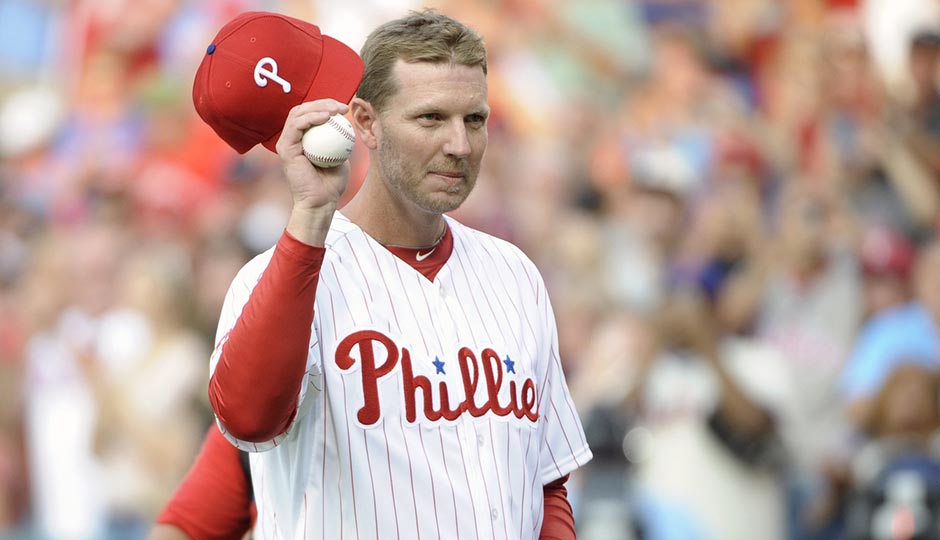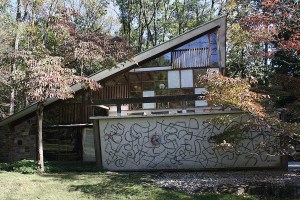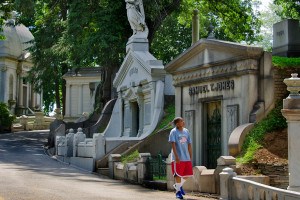Roy Halladay Looks Back on His Phillies Years

Roy Halladay acknowledging the crowd before throwing out a ceremonial first pitch in August 2014. Photo: Eric Hartline, USA Today Sports
It was another night on the road for the big man, another night in a hotel in between games. He called the team together to relax and have some simple, old-fashioned fun: pizza and a movie. Maybe that would keep them from running through the hallways.
They sat around and told jokes and talked baseball. But one player was fixated on a video he’d found on iTunes. Puzzled, he turned to Roy Halladay for some clarity. “Coach,” the 12-year-old boy said, “is that you?”
Halladay peered at the recording. Yeah, that was him alright — slightly younger, lean and long-limbed as ever, wrapped in red pinstripes that flowed down from a face that was a steely mask of determination. “Did you win this game?” the boy asked. Just saying yes would’ve been an understatement. The game in question was from October 6th, 2010, the first time Halladay tasted the postseason after 13 long years as a big leaguer. He made history that night, becoming just the second major league pitcher ever to throw a no-hitter in the playoffs, slicing and dicing home plate with surgical precision while the Cincinnati Reds flailed helplessly for nine innings, and the Philadelphia region went delirious with joy.
Soon, all of the kids on Ryan Halladay’s traveling baseball team wanted to watch this footage of his dad pitching for the Phillies in Game 1 of what seemed to them like a long ago National League Division Series. “So we put it on. The kids were like, baffled, that I had played major league baseball,” Halladay, 39, says over the phone, laughing breezily. “It was pretty funny. I don’t think very many of them knew I used to play.”
This is life for Halladay now, three years after injuries forced him to retire from the game he loved and dominated with Terminator-like effectiveness. He coaches Ryan’s team, shepherding them on tournaments like the one over the summer that was highlighted by the young players discovering a two-time Cy Young winner was in their midst. He marvels at his 16-year-old son Braden’s eerily similar pitching mechanics. He got a pilot’s license. Sometimes he flies his family down to Key West, or ferries rescue dogs to a nonprofit shelter in Palm Harbor.
And every now and then, Halladay allows himself to look back. “It’s funny you’re calling,” he tells me. He’d just gotten a little Facebook reminder that he was approaching the seven-year anniversary of his trade from the Toronto Blue Jays to the Phillies, a move that was both the culmination of a long-burning desire to play for a contender, and — little did everyone realize — the beginning of the end of a remarkable career. “It just baffles me that it’s been that long already, but you almost go right back to that moment in time.”
HALLADAY’S PHONE RANG BEFORE the start of spring training in 2009. J.P. Ricciardi, the Blue Jays then-general manager, explained that the team was going to embark on a lengthy rebuilding project. Halladay had a year left on his contract; Ricciardi wanted to know if his ace pitcher wanted to stick around or be traded elsewhere. “I told him as much as I loved it in Toronto, if they weren’t going to try to win, I wanted to take the short window of time I had left and go to a team that was,” Halladay says.
The 6-foot-6 right-hander was closing in on his 32nd birthday. He’d been a part of the Blue Jays organization ever since the team made him their first-round draft pick in 1995. He was a coveted pitching prospect, and nearly tossed a no-hitter in just his second start as a rookie in 1998. But Halladay’s career almost derailed two years later. His ERA ballooned to 10.64, and he tumbled back to the bottom rung of the minors, where he flirted with the idea of quitting the game altogether. Might’ve gone through with it, too, if it hadn’t been for his wife, Brandy, who gave him a book: The Mental ABC’s of Pitching. The book’s author, the late sports psychologist Harvey Dorfman, helped Halladay to rebuild his confidence and focus.
In 2002, a reborn Halladay won 19 games and embarked on a decade-long stretch of dominance that would see him become arguably the best pitcher in baseball. He was a throwback in one sense, a horse who refused to come off the mound, tossing more complete games than entire pitching staffs. But he was also very much a modern athlete who invested countless hours in studying up on opponents and keeping his body in perfect shape. Now he wanted out of Toronto, and the list of teams he was willing to go to was short: The Phillies, or Toronto’s AL East rivals, the Yankees and Red Sox.
The Phillies were riding high off their 2008 World Series victory, and the core of the team — Jimmy Rollins, Chase Utley, Ryan Howard, Carlos Ruiz, and Cole Hamels — was still young and healthy, primed for another title run. As the 2009 season barreled toward the July 31st trading deadline, Halladay started mentally preparing himself for a move to Philadelphia. “Just from talking to J.P., it sounded like things were getting close, and it was a matter of just working out the right players,” Halladay says. “It got down to the final day, and then I heard they got Cliff Lee. And I was like, ‘Oh no.'”
Then-general manager Ruben Amaro didn’t want to part with the A-list prospects the Blue Jays wanted for Halladay, so he shipped a handful of others to the Cleveland Indians for Lee and outfielder Ben Francisco. Halladay was crushed. Both the Phillies and Blue Jays happened to be out west at the time, and Halladay coincidentally ran into Phillies travel director Frank Coppenbarger after learning that he hadn’t been traded. “Frank said, ‘Boy, I thought you were going to be with us,’ and I just stormed past him,” Halladay says. “I hope he didn’t remember that.”
Halladay reiterated his desire to be traded in the offseason, but understood his fate was mostly out of his hands. He gave up on worrying about whether a trade would materialize. And then the Blue Jays’ new general manager, Alex Anthopoulos, called with unexpected news in December: a trade to the Phillies had been worked out, so long as Halladay was willing to agree to an extension. “I told him I’d do everything possible to make it happen,” Halladay says.
Accompanied by his wife, he flew to Philadelphia for a physical and to work out the terms of a three-year, $60 million extension — far less than what he could have fetched as a free agent. His arrival in the city was cloaked in secrecy. “They pulled me off the airplane, and instead of going through the jetway, they took me down stairs that were under the airport. I thought, ‘Geez, this is weird,'” he chuckles. “They took us right to a hotel and said, ‘Don’t go anywhere until we tell you.’ We stayed in that room for two days.” Media buzz started to build that the Phillies had something big in the works. “I was super excited,” Halladay says, “right up until I heard they traded Cliff Lee.”
AMARO MANAGED TO MAKE himself both the hero and the villain of a franchise-altering trade, a trait that would come to define his tenure. Lee had been a terrific deadline-deal addition to the 2009 Phillies, a no-nonsense gamer who won over a large chunk of the fan base by beating the Yankees twice in the World Series with trademark nonchalance. But Halladay was Amaro’s white whale, an ace who seemed destined for Cooperstown.
Long-suffering Phillies fans were unaccustomed to the team acquiring players like him, a national star who was still at the top of his game. The idea that the organization could have Halladay and Lee and Hamels at the top of its pitching staff heading into the 2010 season was mind-blowing. The rest of the league cringed in anticipation; this was the stuff dynasties were made of. And yet Amaro traded Lee to the Seattle Mariners as part of the same deal that landed Halladay. He claimed that Lee, who was entering the last year of his contract, wanted to pursue a huge free agent deal that the Phillies probably couldn’t afford. But the move didn’t make a damn bit of sense to fans or pundits, who wondered why the team didn’t just try to win another title in 2010 with an uber-rotation, and then let Lee go chase his fortune.
“That really kind of shocked me,” Halladay says. The trade also left him a little worried. What if the fans and the guys on the team resented him? (We pause here to note here that in addition to a hell of a right arm, Halladay also possesses an otherworldly amount of humility.) “There couldn’t have been a more popular player at that time with the Phillies than Cliff. They had just gotten a taste of him. The newness hadn’t even worn off yet. It was put out there like I was replacing Cliff. And then they gave me number 34, the same number he had, and it was even more like I was replacing him. I honestly anticipated people were going to be upset.”
Breaking news: Everyone loved Roy Halladay. He clicked immediately with his new teammates in spring training, and felt like the team’s pitching coach, Rich Dubee, gave him a new weapon on the mound. “My entire career, I had not been able to throw a changeup that was any kind of effective at all,” he explains. “Rich showed me a split-fingered grip, and it was like the best changeup I had in my life. It became a put-away pitch, a get-ahead pitch.”
Halladay’s starts commanded the full attention of Phillies fans — and just about everyone else in baseball, for that matter. He was in full control out there, weaving his pitches in and out of the strike zone with the ease of a conductor running through a concerto he knew by heart. (Perhaps you remember the perfect game he threw against the Marlins?) On the flip side, Halladay was wowed by the fans who filled up Citizens Bank Park to max capacity every night and followed the team on road trips. “When the game would start, I would be in awe. I just could not believe that I was playing in a place that was that excited, that sold out,” he says. “I would look around at the other guys on the team and think, ‘Man, they expect this. They’re used to this. They’re almost spoiled.’ So it used to frustrate me when we’d lose games. I felt like, we gotta start going here, we gotta start doing better than this!”
The Phillies won 97 games that season, earning their fourth straight trip to the playoffs. Halladay posted a 21-10 record to go along with a 2.44 ERA, four shutouts, and nine complete games. He won his second Cy Young Award for living up to the hype, but it was his postseason performance that people will still be talking about a generation from now. That no-hitter against the Reds was historic, but what’s almost equally impressive is how unfazed Halladay seemed as the game wore on, and the excitement in the ballpark built to a manic level, 46,411 people screaming and clapping and praying and waving their little rally towels.
After sweeping the Reds, the Phillies couldn’t get past the San Francisco Giants in the League Championship Series, a result that was hard to digest. How could the team not make it back to the World Series when they had Roy-freaking-Halladay? But the misery gave way to hysteria when Amaro re-signed Lee in the offseason to a 5-year, $120 million contract — so much for not being able to afford him, eh? — and the city had a baseball version of the Fab Four: Halladay, Lee, Roy Oswalt, Hamels. Surely this would be enough to get them back to the promised land.
I really, really don’t want to type “You know what happened next,” but we’re here anyway, so: The 2011 Phillies won a franchise-record 102 games. Halladay and Lee were every bit the killer 1-2 punch that everyone thought they’d be, and Hamels was terrific. You couldn’t walk down a block in this town without seeing red T-shirts and hats and jerseys. But the playoffs — oh God. That series against the fucking St. Louis Cardinals, the whole thing ending at Citizens Bank Park in Game 5 of the Division Series, Halladay losing to his old friend Chris Carpenter 1-0, the cruel, final image of Howard blowing out his Achilles while trying to run to first base.
“Those two seasons were the most exciting two years I had in my entire career, by a long shot,” Halladay says. “But by the same token, the endings of both of those seasons were probably the two most painful things I’ve ever dealt with in baseball.” The team was aging, and its offensive stars were clearly losing a step, but the conventional wisdom was that Halladay would go on cementing his Hall of Fame credentials for a few more seasons. But then shoulder and back injuries intruded, and Halladay came to the realization that his career had reached the finish line.
“At the time, to not really have a decision in how I wanted my career to end, I felt, ‘How cruel is this?’ Looking back on it though, it might have been a blessing in disguise,” he says. “Look at Peyton Manning and guys like that. I can’t imagine how I would feel walking away from the sport and always questioning if I could have done more. It would have driven me up the wall.”
So he walked away. He flirted with the idea of getting right back in the game — maybe a job in a front office, or working with minor league pitchers. But he couldn’t figure out if he really wanted something like that, or just felt compelled to be a part of a major league organization out of habit. “For a lot of athletes, you’ve been playing since you were five or six years old. It’s something you’ve done your entire life. When it’s not there, it’s like, ‘Well, who am I? What am I all about?’ It takes a while to figure it out.”
Halladay has moved forward by focusing on his boys, his wife, his hobbies. Flying requires him to study and prepare and control his adrenaline, and in that way, he gets to relive a small part of what made him such a successful ballplayer. He sees Hamels and Utley and Ruiz on TV now, playing for other teams, and it feels like he’s been retired for 15 years, not three. But the past — the sellouts at Citizens Bank Park, the smell of the grass, the roar of the crowd — is never that far away. All he has to do is remember.
Follow @dgambacorta on Twitter.


